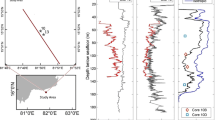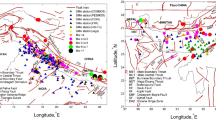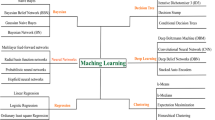Abstract
Modelling of anomalous geological source from the gravity data is vital for understanding the crustal/sub-crustal interface depths and associated hazard assessment. Two-dimensional radial power spectra have usually been used to infer average depth of protuberant geological structures, which lack details of dimensional comprehension of lateral interfaces. Here in this study, we implement jointly scaled conjugate gradient-based Bayesian neural network (SCG-BNN) scheme with variogram modelling to carve out shallow and deeper interfaces of complex geological terrain of Eastern Indian Shield, India, using Bouguer gravity anomaly (BGA) and altitude variations data. Our “learner codes” uses the SCG-BNN optimization algorithm to build up a statistical model involving appropriate control parameters for the modelling of shallow and deeper interfaces. We have also compared the proposed SCG-BNN modelling results with the results of both conventional artificial neural networks (ANNs) schemes (e.g. conjugate gradient-based ANNs (CG-ANN) and SCG-ANN) and support vector regression (SVR) modelling to demonstrate the robustness of the underlying method. Comparative analysis suggests that the SCG-BNN model produced superior results than the results of CG-ANN, SCG-ANN and SVR models. The results based on SCG-BNN analysis and variogram modelling have identified the existence of three conspicuous fault structures, namely Malda–Kishanganj Fault, Munger–Saharsha Ridge Marginal Fault and Katihar Fault. The analyses also significantly minimize prediction error in three independent datasets (viz. training, validation and test), enhancing the precision of estimated shallow and deeper interface depths and thereby extenuating feasibility of “SCG-BNN” learner code. We, therefore, conclude that the underlying approach is robust to model various interface depths and generate precisely variation in the shallow and deeper interfaces with appropriate input data from altitude variation and BGA. The “SCG-BNN learner scheme” may potentially be used to exploit interface depths from several other complex tectonic regions.
















Similar content being viewed by others
References
Talwani M, Worzel JL, Landisman M (1959) Rapid gravity computations for two dimensional bodies with application to the Mendocino Submarine Fracture Zone. J Geophys Res 64:49–59
Cordell L, Henderson RG (1968) Iterative three-dimensional solution of gravity anomaly data using a digital computer. Geophysics 33(4):596–601
Lowrie W (2007) Fundamentals of geophysics, 2nd edn. Cambridge University Press, New York
Bott MHP (1960) The use of rapid digital computing methods for direct gravity interpretation of sedimentary basins. Geophys J R Astron Soc 3:63–67
Spector A, Grant FS (1970) Statistical models for interpreting aeromagnetic data. Geophysics 35:293–302
Maus S, Dimri V (1996) Depth estimation from the scaling power spectrum of potential fields? Geophys J Int 124:113–120
Bhattacharyya BK (1966) Continuous spectrum of the total magnetic anomaly due to a rectangular prismatic body. Geophysics 31:97–121
Connard G, Couch R, Gemperle M (1983) Analysis of aeromagnetic measurements from the Cascade Range in central Oregon. Geophysics 48:376–390
Naidu PS (1968) Spectrum of the potential field due to randomly distributed sources. Geophysics 33:337–345
Bansal AR, Dimri VP (2001) Depth estimation from the scaling power spectral density of nonstationary gravity profile. Pure appl Geophys 158:799–812
Dash NB, Panda SN, Remesan R, Sahoo N (2010) Hybrid neural modeling for groundwater level prediction. Neural Comput Appl 19:1251–1263
Karami H, Ehteram M, Mousavi SF et al (2018) Optimization of energy management and conversion in the water systems based on evolutionary algorithms. Neural Comput Appl. https://doi.org/10.1007/s00521-018-3412-6
Ulkat D, Günay ME (2018) Prediction of mean monthly wind speed and optimization of wind power by artificial neural networks using geographical and atmospheric variables: case of Aegean Region of Turkey. Neural Comput Appl 30:3037. https://doi.org/10.1007/s00521-017-2895-x
Najah A, El-Shafie A, Karim OA, El-Shafie AH (2013) Application of artificial neural networks for water quality prediction. Neural Comput Appl 22(Suppl 1):S187–S201
Poulton M (2001) Computational neural networks for geophysical data processing. Pergamon, Oxford
Maiti S, Tiwari RK, Kumpel HJ (2007) Neural network modelling and classification of lithofacies using well log data: a case study from KTB borehole site. Geophys J Int 169:733–746
Devilee RJR, Curtis A, Roy-Chowdhury K (1999) An efficient probabilistic neural network approach to solving inverse problems: inverting surface wave velocities for Eurasian crustal thickness. J Geophys Res 104(12):28841–28856
Abdel Zaher M, Senosy MM, Youssef MM, Ehara S (2009) Thickness variation of the sedimentary cover in the SouthWestern Desert of Egypt as deduced from Bouguer gravity and drill-hole data using neural network method. Earth Planets Space 61:659–674
Abedi M, Afshar A, Ardestani VE, Norouzi GH, Lucas C (2010) Application of various methods for 2D inverse modeling of residual gravity anomalies. Acta Geophys 58(2):317–336
Osman O, Muhittin AA, Ucan ON (2006) A new approach for residual gravity anomaly profile interpretations: forced Neural Network (FNN). Ann Geofis 49(6):1201–1208
Osman O, Muhittin Albora A, Nuri UO (2007) Forward modeling with forced neural networks for gravity anomaly profile. Math Geol 39:593–605
Eslam E, Salem A, Ushijima K (2001) Detection of cavities and tunnels from gravity data using a neural network. Explor Geophys 32(3/4):204–208
Kaftan I, Salk M, Senol Y (2011) Evaluation of gravity data by using artificial neural network case study: seferihisar geothermal area (Western Turkey). J Appl Geophys 75(4):711–718
Al-Garni MA (2013) Inversion of residual gravity anomalies using neural network. Arab J Geosci 6:1509–1516
Aires F (2004) Neural network uncertainty assessment using Bayesian statistics with application to remote sensing: 1. Network weights. J Geophys Res 109:D10303. https://doi.org/10.1029/2003JD004173
Calster BV, Timmerman D, Nabney IT, Valentin L, Testa AC, Holsbeke CV, Vergote I, Huffel SV (2008) Using Bayesian neural networks with ARD input selection to detect malignant ovarian masses prior to surgery. Neural Comput Appl 17:489–500
Karmakar M, Maiti S (2019) Short term memory efficient pore pressure prediction via Bayesian neural networks at Bering Sea slope IODP expedition 323. Measurement 135:852–868. https://doi.org/10.1016/j.measurement.2018.12.034
Hippert HS, Tylor JW (2010) An evaluation of Bayesian techniques for controlling model complexity and selecting inputs in a neural network for short-term load forecasting. Neural Netw 23:386–395
Maiti S, Tiwari RK (2010) Neural network modeling and an uncertainty analysis in Bayesian framework: a case study from the KTB borehole site. J Geophys Res 115:B10208. https://doi.org/10.1029/2010JB000864
Tiwari RK, Maiti S (2011) Bayesian neural network modeling of tree-ring temperature variability record from the Western Himalayas. Nonlinear Process Geophys 18:515–528. https://doi.org/10.5194/npg-18-515-2011
Ojha M, Maiti S (2016) Sediment classification using neural networks: an example from the site-U1344A of IODP Expedition 323 in the Bering Sea. Deep Sea Res II Top Stud Oceanogr 125–126:202–213. https://doi.org/10.1016/j.dsr2.2013.03.024
Das A, Maiti S, Naidu S, Gupta G (2017) Estimation of spatial variability of aquifer parameters from geophysical methods: a case study of Sindhudurg district, Maharashtra, India. Stoch Environ Res Risk Assess 31:1709–1726. https://doi.org/10.1007/s00477-016-1317-4
Bishop CM (1995) Neural networks for pattern recognition. Oxford University Press, Oxford
Nabney IT (2004) Netlab algorithms for pattern recognition. Springer, New York
Wang W, Xu Z, Lu W, Zhang X (2003) Determination of the spread parameter in the Gaussian kernel for classification and regression. Neuro Comput 55:643–663
Naskar DC, Das LK, Rai MK (2016) Insight into the tectonic and crustal understanding of lessar Himalayas along Purnea-Sevoke transect through geophysical studies. J Ind Geophys Union 20:506–515
Verma RK (1991) Geodynamics of the Indian Peninsula and the Indian plate margin. Oxford and IBH Publishing Co. Ltd., New Delhi, p 357. ISBN 978-81-204-0568-4
Valdiya KS (1976) Himalayan transverse faults and their parallelism with subsurface structures of north Indian plains. Tectonophysics 32:352–386
Jade S et al (2007) Estimates of interseismic deformation in northeast India from GPS measurements. Earth Planet Sci Lett 263:221–234
Mukul M, Jade S, Ansari K, Matin A (2014) Seismotectonic implications of strike–slip earthquakes in the Darjiling–Sikkim Himalaya. Curr Sci 2(25):198–210
Mishra OP (2014) Intricacies of the Himalayan seismotectonics and seismogenesis: need for integrated research. Curr Sci 106(2):176–187
Bhukta K, Khan PK, Mandal P (2018) Upper mantle anisotropy inferred from shear wave splitting beneath the Eastern Indian Shield region. Geosci Front 9:1911–1920
Agarwal RP, Bhoj R (1992) Evolution of Kosi river fan, India: structural implications and geomorphic significance. Int J Remote Sens 13(10):1891–1901
Mohanty WK, Verma AK, Vaccari F, Panza GF (2013) Influence of epicentral distance on local seismic response in Kolkata city, India. J Earth Syst Sci 2:321–338
Gupta H, Gahalaut VK (2014) Seismotectonics and large earthquake generation in the Himalayan region. Gondwana Res 25:204–213
Singh DD, Gupta HK (1980) Source dynamics of two great earthquakes of the Indian subcontinent: the Bihar-Nepal earthquake of January 15, 1934 and the earthquake of May 30, 1935. Bull Seismol Soc Am 70(3):757–773
Dasgupta S (1993) In Bihar-Nepal earthquake August 20 1988. Geological Survey of India Special Publication No. 31, pp 60–81
Dasgupta S, Pande D, Ganguly Z, Iqbal K, Sanyal K, Venkatraman NV, Sural B, Harendranath L, Mazumder K, Sanyal S, Roy A, Das LK, Misra PS, Gupta HK (2000) Seismotectonic atlas of India and its environs. Geological Survey of India, Bangalore
Dasgupta S, Mukhopadhyay B, Mukhopadhyay M, Nandy DR (2013) Role of transverse tectonics in the Himalayan collision: further evidences from two contemporary earthquakes. J Geol Soc India 81:241–247
Gansser A (1964) Geology of the Himalayas. Interscience Publishers, London, p 289
Jain V, Sinha R (2005) Response of active tectonics on the alluvial Baghmati river, Himalayan foreland basin, eastern India. Geomorphology 70:339–356
Singh AP, Kumar N, Singh B (2004) Magmatic underplating beneath the Rajmahal Traps: gravity signature and derived 3-D configuration. Earth Plant Sci 113:759–769
Roy AK, Paine DP, Sett S, Bhattacharya HN (2012) Gravity-magnetic and magneto-telluric surveys in Purnea Onland Basin, India: a case history. In: 9th Biennial international conference and exposition on petroleum geophysics, Hyderabad, p 281
Dasgupta S, Mukhopadhyay M, Nandy DR (1987) Active tectonic feature in the central part of Himalaya. Tectonophysics 136:255–264
Banerjee P, Burgmann R (2002) Convergence across the northwest Himalaya from GPS measurements. Geophys Res Lett 29(13):31–34. https://doi.org/10.1029/2002GL015184
MacKay DJC (1992) A practical Bayesian framework for back-propagation networks. Neural Comput 4(3):448–472
Van der Baan M, Jutten C (2000) Neural networks in geophysical applications. Geophysics 65:1032–1047
Willmott CJ (1981) On the validation of models. Phys Geogr 2:184–194
Acknowledgements
Authors are thankful to the Director, IIT (ISM), Dhanbad, for his kind permission to publish the work. RKT is grateful to DAE for the award of RRF. We gratefully acknowledge the full financial support from the Ministry of Earth Sciences (MoES), Govt. of India, New Delhi, India (Grant No: MoES/P.O. (Geosci)/44/2015), for this research. We are grateful to the editor, associate editor and three anonymous reviewers for their comments and constructive criticism on earlier versions of this manuscript.
Author information
Authors and Affiliations
Corresponding author
Ethics declarations
Conflict of interest
We certify that there is no actual or potential conflict of interest in relation to this article.
Additional information
Publisher's Note
Springer Nature remains neutral with regard to jurisdictional claims in published maps and institutional affiliations.
Rights and permissions
About this article
Cite this article
Maiti, S., Ravi Kumar, C., Sarkar, P. et al. Interface depth modelling of gravity data and altitude variations: a Bayesian neural network approach. Neural Comput & Applic 32, 3183–3202 (2020). https://doi.org/10.1007/s00521-019-04276-9
Received:
Accepted:
Published:
Issue Date:
DOI: https://doi.org/10.1007/s00521-019-04276-9




